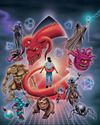
BABY J, the latest stand-up from John Mulaney, is a herculean effort, but what exactly that effort aims to achieve is not entirely clear. After his highly public, intensely tumultuous past several years—an intervention, a long period in rehab, a divorce, a sudden new relationship, a new baby—the special is both a presentation of who the comedian and actor was during that period and an attempt to align that person with who he is now. It’s designed as a self-examination: He wants to be able to laugh at that guy he used to be and for the audience to laugh at that guy too. So he tries to create a lot of space between them. That Mulaney who was addicted to substances? He’s certainly related to the guy standing onstage, but he’s not quite the same. He’s an object to be held up and tut-tutted over, a guy we can laugh at safely now because he no longer exists.
Some distance from a past self is necessary in this kind of storytelling— without it, there’s just a rattling off of events with no room for artistic transformation. But Mulaney attacks Baby J less like a product of creative consideration and more as if he’s examining a severed limb. He is so entirely, confidently unruffled. His sharp suit and shiny dress shoes are back; he’s on the big Boston Symphony Hall stage. Inside the stories he tells is the implication that we should now understand that this old-timey soft-shoe act was always a cover for some very dark stuff. And yes, maybe all this is an attempt to reconcile the Mulaney everyone knew onstage with the Mulaney who lived behind the scenes. The act has returned, but this time it’s fine! See, look—there’s so much distance! We can laugh now! Except when you create that much separation between who you are and who you were, reconciliation starts to look like dissociation.
Diese Geschichte stammt aus der April 24 - May 07, 2023-Ausgabe von New York magazine.
Starten Sie Ihre 7-tägige kostenlose Testversion von Magzter GOLD, um auf Tausende kuratierte Premium-Storys sowie über 8.000 Zeitschriften und Zeitungen zuzugreifen.
Bereits Abonnent ? Anmelden
Diese Geschichte stammt aus der April 24 - May 07, 2023-Ausgabe von New York magazine.
Starten Sie Ihre 7-tägige kostenlose Testversion von Magzter GOLD, um auf Tausende kuratierte Premium-Storys sowie über 8.000 Zeitschriften und Zeitungen zuzugreifen.
Bereits Abonnent? Anmelden

LIFE AS A MILLENNIAL STAGE MOM
A journey into the CUTTHROAT and ADORABLE world of professional CHILD ACTORS.

THE NEXT DRUG EPIDEMIC IS BLUE RASPBERRY FLAVORED
When the Amor brothers started selling tanks of flavored nitrous oxide at their chain of head shops, they didn't realize their brand would become synonymous with the country's burgeoning addiction to gas.

Two Texans in Williamsburg
David Nuss and Sarah Martin-Nuss tried to decorate their house on their own— until they realized they needed help: Like, how do we not just go to Pottery Barn?”

ADRIEN BRODY FOUND THE PART
The Brutalist is the best, most personal work he's done since The Pianist.

Art, Basil
Manuela is a farm-to-table gallery for hungry collectors.

'Sometimes a Single Word Is Enough to Open a Door'
How George C. Wolfein collaboration with Audra McDonald-subtly, indelibly reimagined musical theater's most domineering stage mother.

Rolling the Dice on Bird Flu
Denial, resilience, déjà vu.

The Most Dangerous Game
Fifty years on, Dungeons & Dragons has only grown more popular. But it continues to be misunderstood.

88 MINUTES WITH...Andy Kim
The new senator from New Jersey has vowed to shake up the political Establishment, a difficult task in Trump's Washington.

Apex Stomps In
The $44.6 million mega-Stegosaurus goes on view (for a while) at the American Museum of Natural History.